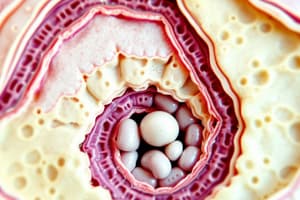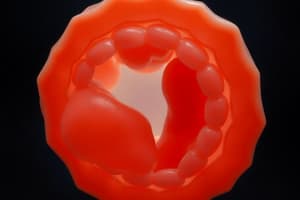Podcast
Questions and Answers
During organogenesis, which of the following is derived from the endoderm?
During organogenesis, which of the following is derived from the endoderm?
- Gut-tube (correct)
- Primitive streak
- Notochord
- Lateral mesoderm
What is the role of the primitive streak during organogenesis?
What is the role of the primitive streak during organogenesis?
- Formation of the notochord
- Development of the lateral mesoderm
- Formation of the gut-tube (correct)
- Formation of the placenta
Which germ layer is responsible for the development of the placenta?
Which germ layer is responsible for the development of the placenta?
- Endoderm
- Trophoblast (correct)
- Mesoderm
- Ectoderm
What is the process by which the neural tube is formed during organogenesis?
What is the process by which the neural tube is formed during organogenesis?
Which structure is associated with the body cavities and blood islands during organogenesis?
Which structure is associated with the body cavities and blood islands during organogenesis?
During organogenesis, which of the following is derived from the ectoderm?
During organogenesis, which of the following is derived from the ectoderm?
What is the process by which the embryo folds in the lateral and cephalocaudal directions during organogenesis?
What is the process by which the embryo folds in the lateral and cephalocaudal directions during organogenesis?
Which structure plays a role in the formation of the placenta during organogenesis?
Which structure plays a role in the formation of the placenta during organogenesis?
What is the key germ layer that gives rise to the liver during organogenesis?
What is the key germ layer that gives rise to the liver during organogenesis?
Which of the following is NOT a key structure derived from the mesoderm during organogenesis?
Which of the following is NOT a key structure derived from the mesoderm during organogenesis?
Flashcards
Endoderm origin
Endoderm origin
The gut tube develops from the endoderm during organogenesis.
Primitive streak role
Primitive streak role
The primitive streak initiates the formation of the gut-tube during organogenesis.
Placenta germ layer
Placenta germ layer
The trophoblast gives rise to the placenta.
Neural tube formation
Neural tube formation
Signup and view all the flashcards
Lateral mesoderm's role
Lateral mesoderm's role
Signup and view all the flashcards
Ectoderm origin
Ectoderm origin
Signup and view all the flashcards
Embryo folding
Embryo folding
Signup and view all the flashcards
Trophoblast function
Trophoblast function
Signup and view all the flashcards
Liver's germ layer
Liver's germ layer
Signup and view all the flashcards
Non-mesoderm structure
Non-mesoderm structure
Signup and view all the flashcards
Study Notes
Organogenesis Overview
- Endoderm derives structures including the gastrointestinal tract, liver, pancreas, and respiratory system.
- The primitive streak marks the beginning of gastrulation, establishing the body's axial structure and facilitating cellular migration for organ formation.
Germ Layers and Their Roles
- The placenta is primarily formed from the trophoblast layer, which is derived from the outer cell mass of the blastocyst.
- Neural tube formation occurs through a process called neurulation, where the neural plate folds and fuses to create the tube that becomes the central nervous system.
- The mesoderm gives rise to structures including muscles, bones, and the circulatory system.
Key Processes in Organogenesis
- Embryonic folding occurs laterally and in the cephalocaudal direction, allowing the embryo to assume a more cylindrical shape necessary for development.
- The sacrococcygeal region is associated with body cavities and blood islands, crucial for early blood cell formation and circulation.
Ectoderm Contributions
- The ectoderm is responsible for forming the epidermis, nervous system, and sensory organs during organogenesis.
- Structures NOT derived from the mesoderm include the epidermis and neural tissues, which originate from the ectoderm.
Essential Germ Layers
- The liver develops from the endoderm as part of the foregut during organogenesis, highlighting its critical role in digestive system formation.
Studying That Suits You
Use AI to generate personalized quizzes and flashcards to suit your learning preferences.




